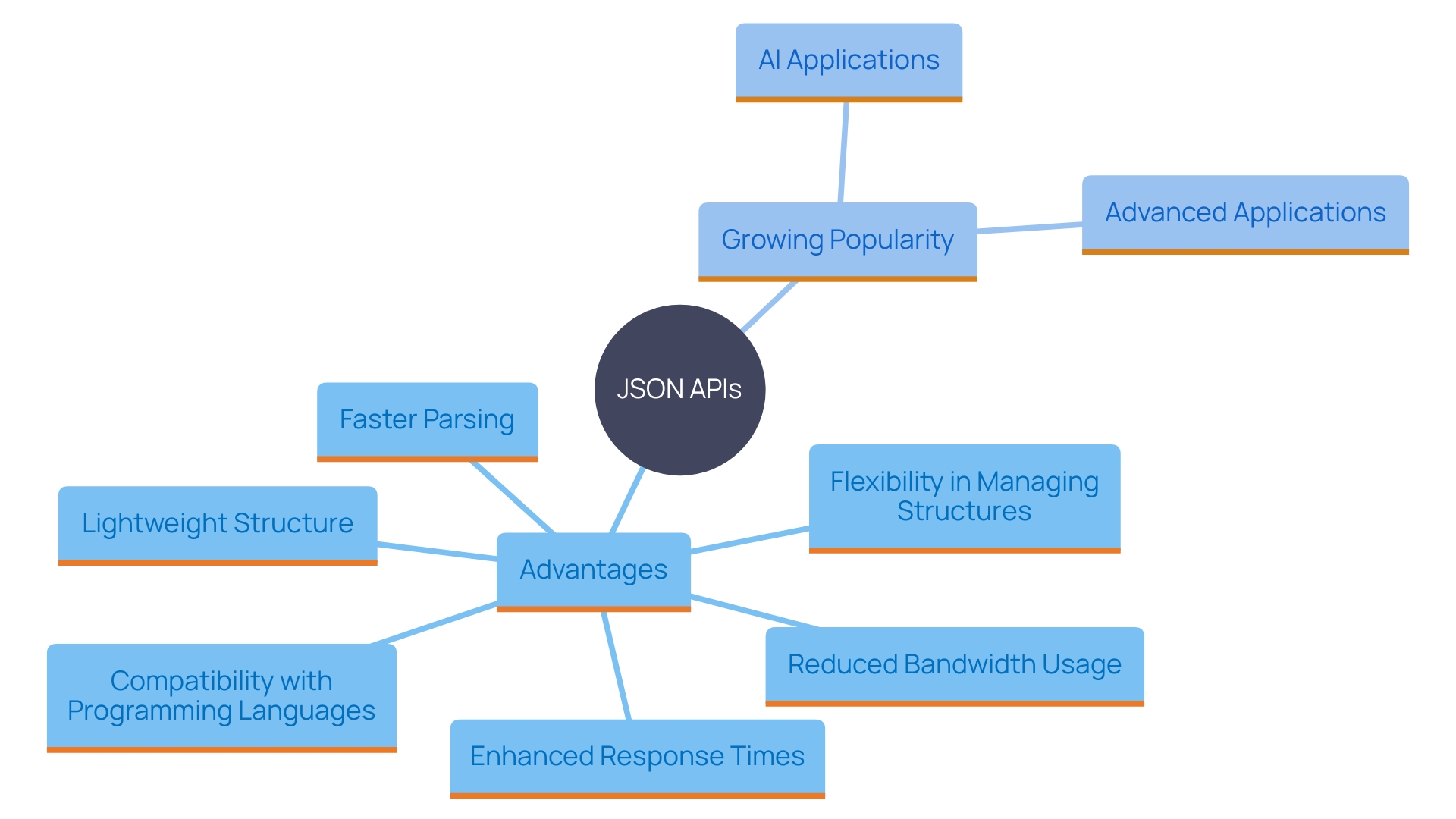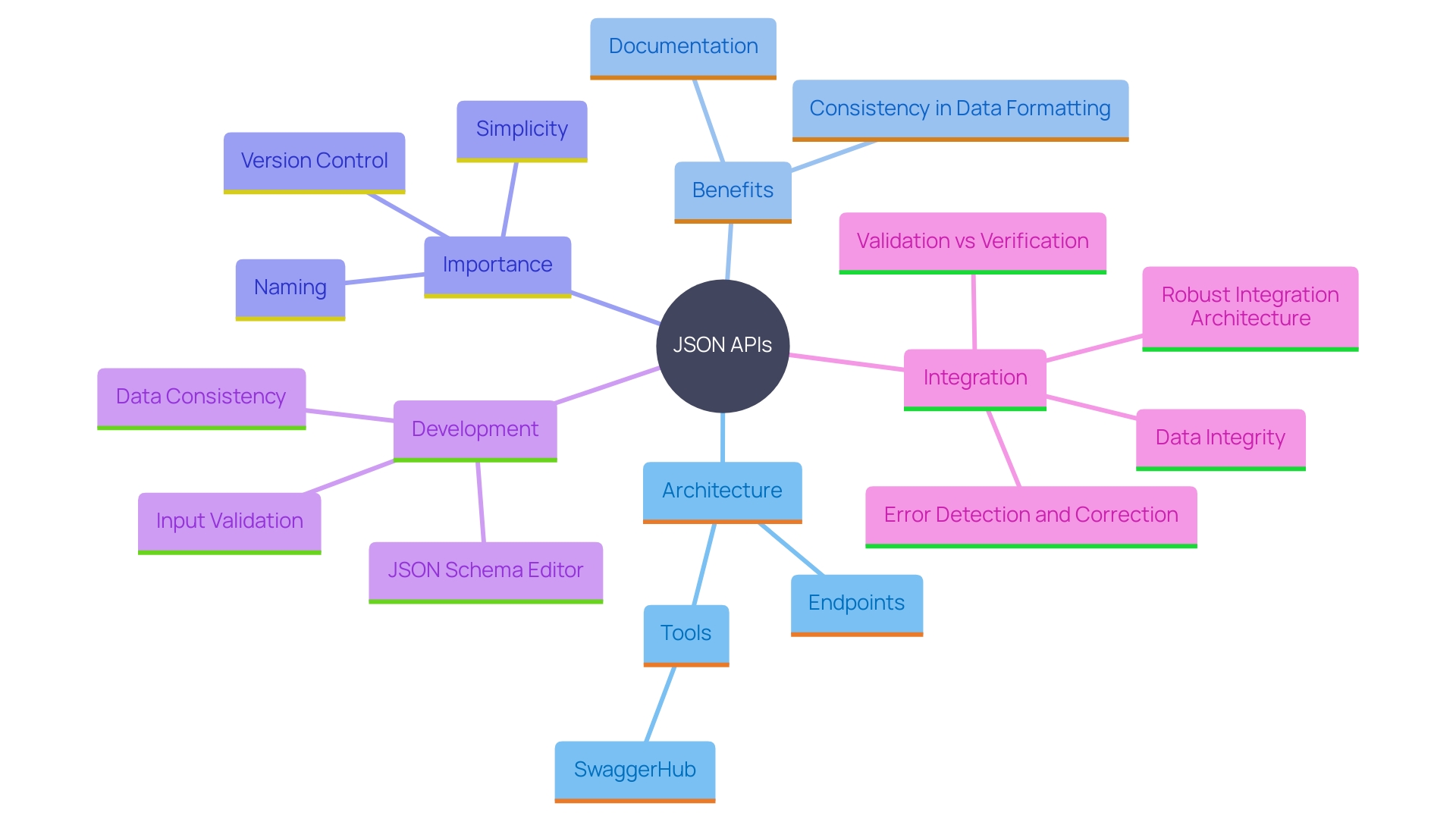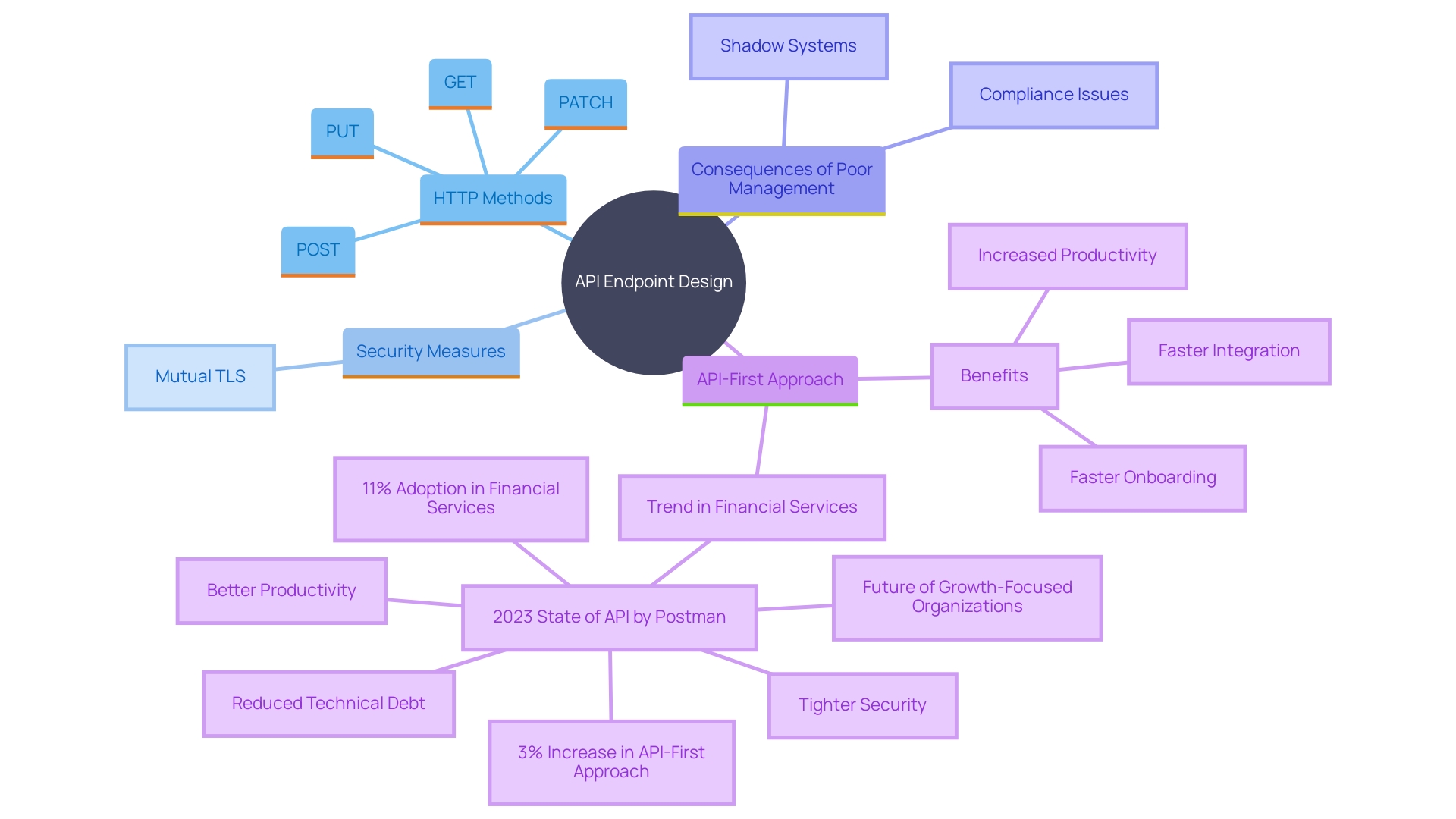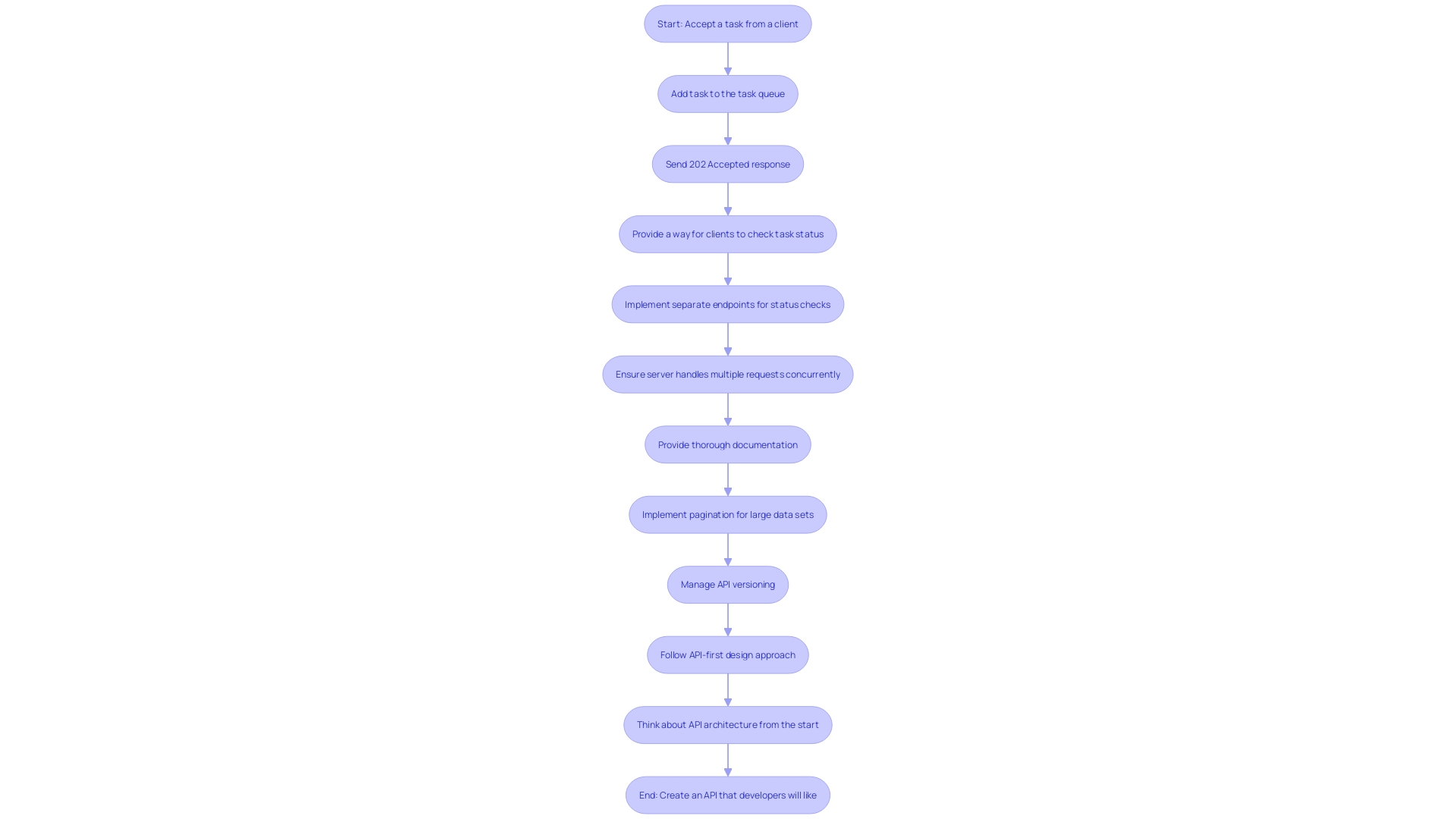Introduction
In the ever-evolving landscape of web development, the efficiency and productivity of data exchange are paramount. JSON (JavaScript Object Notation) APIs have emerged as a powerful solution, offering a streamlined and effective means to communicate between servers and clients. This article delves into the key benefits of JSON APIs, highlighting their lightweight structure and compatibility with a variety of programming languages, which collectively enhance response times and reduce bandwidth usage.
Furthermore, it explores the structured architecture of JSON APIs, the critical role of well-designed endpoints and HTTP methods, and best practices for implementation, ensuring developers can maximize their potential in creating scalable, robust, and efficient applications.
Key Benefits of JSON API
JSON (JavaScript Object Notation) APIs offer a streamlined and efficient method to exchange information, making them particularly suitable for web applications. Due to its lightweight structure, JSON allows for faster parsing and serialization compared to XML, which significantly reduces bandwidth usage and enhances response times. This efficiency is crucial for improving user experience. Additionally, JSON's flexibility in managing intricate structures and its compatibility with most programming languages ensure smooth integration and interoperability across various platforms. Consequently, JSON is gaining more popularity in AI and other sophisticated applications, streamlining information management and reducing errors.

Understanding JSON API Structure
A JSON API utilizes a structure-focused architecture, arranging information into separate object entities. Each item encapsulates characteristics and connections with other elements, offering a clear and organized depiction of intricate models. This approach promotes consistency in data formatting and access, streamlining both development and API consumption. For example, endpoints like /API/v1/products/:id allow developers to access specific resources efficiently. This consistency is vital for creating scalable applications that can adapt and evolve over time, ensuring long-term success in a dynamic technological landscape. As pointed out by industry leaders, strong documentation, including clear Quick Start Guides and code samples, is essential to maximize the potential of application interfaces and facilitate their adoption. Furthermore, with the ongoing advancements in tools like SwaggerHub, developers are empowered to harness the full potential of APIs, driving innovation and efficiency in software development.

API Endpoints and HTTP Methods
API endpoints function as particular URLs that enable interactions between clients and servers, each relating to unique assets or groups of assets. These endpoints are critically important in defining the operations that can be performed on these assets using HTTP methods, such as GET, POST, PUT, and PATCH. Each method carries its unique functionality, with GET used to retrieve information, POST to submit information for processing, PUT to create or replace a resource, and PATCH to partially update existing resources.
Effective API design hinges on thoughtful endpoint naming, method selection, and robust authentication mechanisms like mutual TLS, which authenticates both client and server, ensuring secure data exchanges. This meticulous approach not only simplifies integration for other developers but also enhances overall application performance and security.
The importance of properly managed interfaces is highlighted by the potential dangers presented by shadow systems, which can result in compliance violations and security breaches. Proper cataloging and management of these endpoints are vital, as underscored by recent trends showing a 3% increase in the API-first approach, with financial services leading the adoption for improved productivity, faster onboarding, and seamless integration.
By adhering to best practices in endpoint design and method application, developers can create application programming interfaces that are not only functional and robust but also resilient and future-proof, meeting both immediate needs and long-term goals.

Implementing JSON API: Best Practices
To implement a robust JSON API, adhering to best practices is essential. Proper use of HTTP status codes, such as 200 for success and 404 for not found, ensures clear communication of success or error states. Implementing pagination for large datasets enhances performance and user experience by loading data in manageable chunks. Thorough documentation is vital; it should provide clear, detailed descriptions of operations, parameters, and response types, enhancing usability and reducing support costs. Versioning your API is crucial as it helps manage changes, maintains backward compatibility, and allows for iterative improvements without disrupting existing client applications. As SmartBear's advancements in API tools show, continuous innovation and attention to detail can significantly boost the effectiveness and longevity of your APIs.

Conclusion
The advantages of using JSON APIs in web development cannot be overstated. Their lightweight structure not only facilitates faster data parsing and serialization but also significantly reduces bandwidth usage. This efficiency translates directly into enhanced user experiences, making JSON an increasingly popular choice for developers working with complex data structures across various platforms.
As the landscape of technology continues to evolve, the adaptability of JSON APIs positions them as a vital tool in advanced applications, including AI.
Understanding the structured architecture of JSON APIs is crucial for developers aiming to create scalable and robust applications. By organizing data into distinct resource objects, JSON APIs promote consistency and clarity, making it easier to manage complex data models. The thoughtful design of endpoints and the strategic use of HTTP methods further enhance the efficiency of data exchanges, allowing developers to interact seamlessly with resources.
This meticulous approach not only fosters better integration but also addresses security concerns, ensuring that applications remain resilient in the face of emerging challenges.
Implementing best practices in JSON API development is essential for maximizing effectiveness. The appropriate use of HTTP status codes, pagination for large datasets, and comprehensive documentation contribute to a more user-friendly experience. Furthermore, versioning APIs allows for continuous improvement while maintaining compatibility with existing applications.
By adhering to these guidelines, developers can ensure their APIs are not only functional but also equipped to meet future demands, thereby driving innovation and productivity in the ever-changing world of web development.
Frequently Asked Questions
What is a JSON API?
A JSON API (JavaScript Object Notation Application Programming Interface) is a method of exchanging information in a structured format that is lightweight and efficient, making it particularly suitable for web applications.
Why is JSON preferred over XML?
JSON is preferred over XML because of its lightweight structure, which allows for faster parsing and serialization. This results in reduced bandwidth usage and enhanced response times, ultimately improving user experience.
What are the benefits of using JSON in applications?
The benefits of using JSON include faster processing due to its lightweight nature, flexibility in managing complex data structures, compatibility with most programming languages, and growing popularity in advanced applications like AI.
How does a JSON API structure its data?
A JSON API uses a structure-focused architecture, organizing information into separate object entities. Each entity encapsulates characteristics and relationships, promoting consistency in data formatting and access.
What is an API endpoint?
An API endpoint is a specific URL that allows interaction between clients and servers. Each endpoint relates to unique assets or groups of assets and defines operations that can be performed on these assets using HTTP methods.
What HTTP methods are commonly used in API endpoints?
Common HTTP methods include GET (retrieve information), POST (submit information for processing), PUT (create or replace a resource), and PATCH (partially update existing resources).
Why is effective API design important?
Effective API design is crucial as it simplifies integration for developers, enhances application performance and security, and prevents compliance violations and security breaches associated with shadow systems.
What best practices should be followed when implementing a JSON API?
Best practices for implementing a JSON API include proper use of HTTP status codes for clear communication, implementing pagination for large datasets to enhance performance, providing thorough documentation, and versioning the API to maintain backward compatibility.
How does documentation benefit a JSON API?
Thorough documentation enhances usability, reduces support costs, and allows developers to understand how to interact with the API effectively, including operations, parameters, and response types.
What tools can help in the development of APIs?
Tools like SwaggerHub can empower developers by providing a platform for designing, documenting, and managing APIs, thus driving innovation and efficiency in software development.




